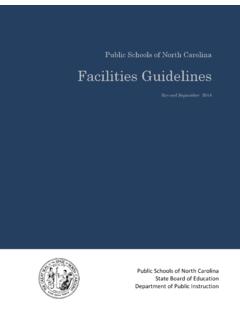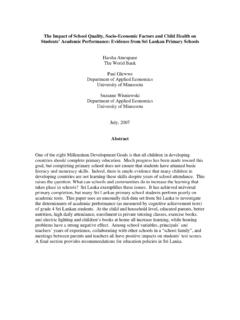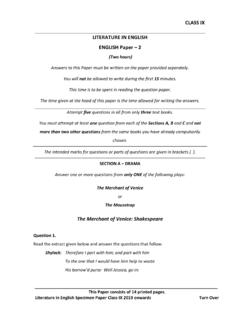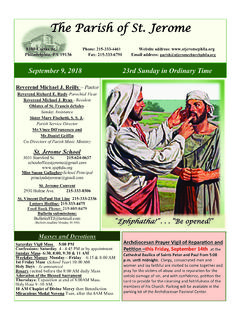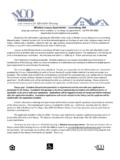Transcription of NSW DEPARTMENT OF EDUCATION AND TRAINING
1 This publication assists applicants for Year 7 entry to selective high schools to become more familiar with the Selective High School Placement Test. Some of the items have not been included for copyright reasons. In the actual Selective High School Placement Test there are 45 questions in reading, 40 in mathematics and 60 in general ability. The Selective High School Placement Test measures ability and is set to discriminate at a very high level. Students who are accustomed to answering most questions in tests correctly should not be discouraged if they get a number of questions wrong. It is very rare for even the highest scoring candidates to score full marks on all components of the Selective High School Placement Test.
2 Selective high school entry does not depend entirely on a student's performance in the Selective High School Placement Test as school assessment scores in English and mathematics are provided by the primary schools. It is important to note that selection committees and appeals panels will not accept students' performance in this sample paper as evidence of academic merit for the purposes of entry into a selective high school in any future year. NSW DEPARTMENT OF EDUCATION AND TRAINING SELECTIVE HIGH SCHOOL PLACEMENT READING SAMPLE TEST 3 INSTRUCTIONS 1 You have 40 minutes to complete the test. It contains 45 questions. 2 This test contains several passages. In most passages every fifth line is numbered on the right-hand side to help you answer the questions.
3 3 Read each passage and then mark your answer to the questions on the separate answer sheet. 4 With each question there are four possible answers A, B, C or D. For each question you are to choose the ONE answer you think is best. To show your answer, fill the oval for one letter (A, B, C or D) on the answer sheet in the section headed English Language. 5 If you decide to change an answer, rub it out completely and mark your new answer clearly. 6 If you want to work anything out you may write on the question booklet. 7 If you need the help of the supervisor during the test, raise your hand. DO NOT OPEN THIS BOOKLET UNTIL YOU ARE TOLD Published by the Australian Council for Educational Research Prospect Hill Road, Camberwell, Victoria 3124.
4 Copyright NSW DEPARTMENT of EDUCATION and TRAINING . Acknowledgments Marjorie Barnard, The lottery , in Mary Lord (ed.) The Penguin Best Australian Short Stories, Penguin Books, Ringwood, 1991. Madeline Kempster, Margaret Backhouse and Ella Turnbull (eds.), More Verse by Young Australians, Rigby, Adelaide, 1970. Adapted from ABC Radio National website: transcript of 8/02/2002, The Sports Factor, Winter Olympics Sports of Snow and Ice . Bruce Carter, The Children Who Stayed Behind , Hamish Hamilton, included in Delves and W. G. Tickell, Themes and Responses Two, North Melbourne, Cassell Australia, 1972. Michael McGirr, Tim Winton: the Writer and his Work, Macmillan EDUCATION Australia, South Yarra, 1999.
5 Philip Hodgins, Things Happen, HarperCollinsPublishers, Sydney, 1996. Adapted from Amoret and Christopher Scott, The Social History of the Quack , The Saturday Book, 25, edited by John Hadfield, Hutchinson of London, 1965. Katherine Mansfield, Her First Ball and At the Bay , Collected Stories of Katherine Mansfield, Constable and Company Limited, London, 1976. Reasonable efforts have been made to gain publication approval for the Internet. If an author or publisher believes copyright permission is required they should contact the NSW DEPARTMENT of EDUCATION and TRAINING . R2 PRACTICE QUESTIONS INSTRUCTIONS The practice questions P1 to P10 below are examples of questions in the English Language, Mathematics and General Ability tests.
6 To show your answer, fill the oval for one letter (A, B, C or D) on the separate answer sheet in the shaded section headed Practice Questions . There are four easy questions, followed by six harder questions. If you have any questions, raise your hand. You have ten minutes to complete the PRACTICE QUESTIONS. When you have finished them, put your pencil down. Start work on the practice questions now. EASY PRACTICE QUESTIONS Mathematics English Language Read the following passage and answer P1 and P2. Notice how the fifth line in the passage is numbered on the right-hand side. P3 20 + 30 = = A 10 B 50 C 500 When Chuang Tzu, a Chinese sage, was angling in the river P u, the queen sent two officers of state to announce that the queen wished to entrust him with the management of her domain.
7 D 600 General Ability 5 P4 CHICKEN is to HEN as CALF is to _____ ? P1 What was Chuang Tzu doing in the river? A COW A fishing B BIRD B playing C BABY C washing D ANIMAL D swimming P2 The queen was entrusting Chuang Tzu with GO STRAIGHT ON A a secret. B a holiday. C her family. D a responsible job. Go straight on to P3 and P4 R3 HARDER PRACTICE QUESTIONS Kezia s Grandma The following passage is from a short story. Kezia and her grandmother are at a beach house, resting in the middle of a summer day.
8 Kezia has asked her grandmother why she keeps staring at the wall. The old woman sighed, whipped the wool twice round her thumb, and drew the bone needle through. She was casting on. 5 10 15 I was thinking of your Uncle William, darling, she said quietly. My Australian Uncle William? said Kezia. She had another. Yes, of course. The one I never saw? That was the one. Well, what happened to him? Kezia knew perfectly well, but she wanted to be told again. He went to the mines and he got a sunstroke there and died, said old Mrs Fairfield. Kezia blinked and considered the picture again .. A little man fallen over like a tin soldier by the side of a big black hole.
9 Does it make you sad to think about him, grandma? She hated her grandma to be sad. It was the old woman s turn to consider. Did it make her sad? To look back, back. To stare down the years, as Kezia had seen her doing. P5 The grandmother talks to Kezia in a way that A is kind and respectful. B is impatient and angry. C suggests the grandmother is like a teacher. D suggests the grandmother doesn t understand Kezia. P6 A little man fallen over like a tin soldier (lines 12 13) is A Kezia s idea of her Australian Uncle William. B Kezia s memory of a toy her uncle had given her. C the way Kezia s grandmother had described Uncle William. D a description of a picture in the room where Kezia and her grandmother are talking.
10 R4 Mathematics P7 This square target has nine sections. Quoc tries to work out how many ways he can throw three darts at the target so that they all land in a straight line. Two of the ways are shown. Note that the centre square has been hit twice. The order in which the darts hit does not matter. In total, how many different ways can three darts land on this target in a straight line? A five B eight C nine D more than nine P8 This square has an area of 400 square centimetres. A new smaller square is made: all the sides are decreased to one quarter of their original length. The area of the smaller square is A 25 square centimetres B 50 square centimetres C 80 square centimetres D 100 square centimetres General Ability P9 The numbers in each pair of brackets go together following the same rule.




